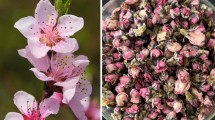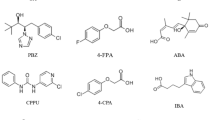Abstract
In this work, we have developed an efficient method for the rapid extraction and separation of triterpene acids from 37 different varieties of raspberry via ultrasound-assisted dispersive liquid–liquid microextraction (UA-DLLME). The triterpene acids were then determined by high-performance liquid chromatography (HPLC) with fluorescence detection using benzimidazo-[2,1-b]quinazolin-12(6H)-one-5-ethyl-p-toluenesulfonate (BQETS) as the labeling agent. Five triterpene acids, including asiatic acid (AA), maslinic acid (MA), corosolic acid (CA), oleanolic acid (OA) and betulinic acid (BA), were extracted by UA-DLLME using chloroform and acetone as the extracting and dispersing solvents, respectively. After extraction and nitrogen flushing, the extracts were simultaneously characterized by HPLC based on pre-column derivatization using BQETS, a new labeling agent synthesized in our laboratory. Several key parameters affecting the extraction efficiency and derivatization yields were investigated and optimized by response surface methodology (RSM) combined with Box–Behnken design (BBD). The method was further validated for linearity (correlation coefficient R 2 > 0.9979), precision (RSD = 0.23–2.45 %), and recovery (RSD = 90–106.5 %). The limits of detection (LODs) and the limits of quantification (LOQs) were determined to be within the range of 1.83–7.69 µg/L and 6.06–25.47 µg/L, respectively. This is the first report of the use of BQETS as a pre-column derivatization agent for the determination of triterpene acids in real samples. The proposed method has been applied to the determination of five triterpene acids in 37 different raspberry varieties with significantly increased sensitivity compared to other methods. The results obtained indicate that the contents of triterpene acids vary significantly across different raspberry varieties.




Similar content being viewed by others
References
Chen Y, Wang MF, Rosen RT et al (1999) 2, 2-Diphenyl-1-picrylhydrazyl radical-scavenging active components from Polygonum multiflorum Thunb. J Agr Food Chem 47(6):2226–2228
Četojević-Simin DD, Velićanski AS, Cvetković DD et al (2015) Bioactivity of Meeker and Willamette raspberry (Rubus idaeus L.) pomace extracts. Food Chem 166:407–413
Gonzalez-Barrio R, Edwards CA, Crozier A (2011) Colonic catabolism of ellagitannins, ellagic acid, and raspberry anthocyanins. In vivo and in vitro studies. Drug Metab Dispos 39:1680–1688
Verbeyst L, Crombruggen KV, Plancken IV, Hendrickx Marc, Loey AV (2011) Anthocyanin degradation kinetics during thermal and high pressure treatments of raspberries. J Food Eng 105:513–521
Bobinaite B, Pranas Viškelis P, Venskutonis PR (2012) Variation of total phenolics, anthocyanins, ellagic acid and radical scavenging capacity in various raspberry (Rubus spp.) cultivars. Food Chem 132:1495–1501
Dossetta M, Leeb J, Finn CE (2010) Variation in anthocyanins and total phenolics of blackraspberry populations. J Funct Foods 2:292–297
Sariburun S, Şahin S, Demir C et al (2010) Phenolic content and antioxidant activity of raspberry and blackberry cultivars. J Food Sci 75:C328–C335
Mullen W, Stewart AJ, Lean MEJ et al (2002) Effect of freezing and storage on the phenolics, ellagitannins, flavonoids, and antioxidant capacity of red raspberries. J Agric Food Chem 50:5197–5201
Mullen W, McGinn J, Lean ME et al (2002) Ellagitannins, flavonoids, and other phenolics in red raspberries and their contribution to antioxidant capacity and vasorelaxation properties. J Agric Food Chem 50(18):5191–5196
Gbaguidi F, Accrombessi G, Moudachirou M et al (2005) HPLC quantification of two isomeric triterpenic acids isolated from Mitracarpus scaber and antimicrobial activity on Dermatophilus congolensis. J Pharm Biomed Anal 39:990–995
Novotny L, Abdel-Hamid ME, Hamza H et al (2003) Development of LC–MS method for determination of ursolic acid: application to the analysis of ursolic acid in Staphylea holocarpa Hemsl. J Pharm Biomed Anal 31:961–968
Gupta A, Sheth NR, Pandey S et al (2013) Determination of ursolic acid in fractionated leaf extracts of Ocimum gratissimum Linn and in developed herbal hepatoprotective tablet by HPTLC. Pharmacogn J 5:156–162
Yu DL, Sakurai Y, Chen CH et al (2006) Anti-AIDS agents 69. Moronic acid and other triterpene derivatives as novel potent anti-HIV agents. J Med Chem 49:5462–5469
Wójciak-Kosior M (2007) Separation and determination of closely related triterpenic acids by high performance thin-layer chromatography after iodine derivatization. J Pharm Biomed Anal 45:337–340
Kontogianni VG, Exarchou V, Troganis A et al (2009) Rapid and novel discrimination and quantification of oleanolic and ursolic acids in complex plant extracts using two-dimensional nuclear magnetic resonance spectroscopy–comparison with hplc methods. Ana Chim Acta 635(2):188–195
Guo S, Duan JA, Tang YP et al (2010) Characterization of triterpenic acids in fruits of Ziziphus species by HPLC–ELSD–MS. J Agric Food Chem 58(10):6285–6289
Yuan Y, Zhang H, Sun F et al (2015) Biopharmaceutical and pharmacokinetic characterization of asiatic acid in Centella asiatica as determined by a sensitive and robust HPLC-MS method. J Ethnopharmacol 163:31–38
Yang P, Li Y, Liu X et al (2007) Determination of free isomeric oleanolic acid and ursolic acid in Pterocephalus hookeri by capillary zone electrophoresis. J Pharm Biomed Anal 43(4):1331–1334
Banerjee A, Sane RT, Mangaonkar K et al (2006) Quantitation of oleanolic acid in Oldenlandia corymbosa L. whole-plant powder by high-performance thin-layer chromatography. JPC-J Planar Chromatogr-Mod TLC 19:68–72
Banno N, Akihisa T, Tokuda H et al (2004) Triterpene acids from the leaves of Perilla frutescens and their anti-inflammatory and antitumor-promoting effect. Biosci Biotechnol Biochem 68:85–90
Werner S, Nebojsa S, Robert W et al (2003) Complete assignments of 1H and 13C NMR resonances of oleanolic acid, 18α-oleanolic acid, ursolic acid and their 11-oxo derivatives. Magn Reson Chem 41(8):636–638
Caligiani A, Malavasi G, Palla G et al (2013) A simple GC–MS method for the screening of betulinic, corosolic, maslinic, oleanolic and ursolicacid contents in commercial botanicals used as food supplement ingredients. Food Chem 136(2):735–741
Kartini Piyaviriyakul S, Siripong P et al (2014) HPTLC simultaneous quantification of triterpene acids for quality control of Plantago major L. and evaluation of their cytotoxic and antioxidant activities. Ind Crops Prod 60:239–246
Lv T, Zhao XN, Zhu SY et al (2014) Development of an efficient HPLC fluorescence detection method for brassinolide by ultrasonic assisted dispersive liquid–liquid microextraction coupled with derivatization. Chromatographia 77:1653–1660
Sun YN, Zhang X, Ji ZY et al (2016) Determination of free fatty acids of Chinese Coriandrum sativum L. Using Benzimidazo[2, 1-b] quinazolin-12 (6H)-one-5-ethyl-p-toluenesulfonate as precolumn labeling reagent by LC with fluorescence detection. Chromatographia 79:547–559
Song M, Hang TJ, Wang Y et al (2006) Determination of oleanolic acid in human plasma and study of its pharmacokinetics in Chinese healthy male volunteers by HPLC tandem mass spectrometry. J Pharm Biomed Anal 40:190–196
Claude B, Morin P, Lafosse M et al (2008) Selective solid-phase extraction of a triterpene acid from a plant extract by molecularly imprinted polymer. Talanta 75:344–350
Moradi M, Yamini Y, Seidi S et al (2013) Ultrasound-assisted emulsification microextraction using low density solvent for analysis of toxic nitrophenols in natural waters. Int J Environ Anal Chem 93:199–212
Vas G, Vekey K (2004) Solid-phase microextraction: a powerful sample preparation tool prior to mass spectrometric analysis. J Mass Spectrom 39:233–254
Yan HY, Wang H (2013) Recent development and applications of dispersive liquid–liquid microextraction. J Chromatogr A 1295:1–15
Zhao XN, Lv T, Zhu SY et al (2016) Dual ultrasonic-assisted dispersive liquid–liquid microextraction coupled with microwave-assisted derivatization for simultaneous determination of 20 (S)-protopanaxadiol and 20 (S)-protopanaxatriol by ultrahigh performance liquid chromatography-tandem mass spectrometry. J Chromatogr A 1437:49–57
Leong MI, Fuh MR, Huang SD (2014) Beyond dispersive liquid–liquid microextraction. J Chromatogr A 1335:2–14
Viñas P, Campillo N, López-García I et al (2014) Dispersive liquid–liquid microextraction in food analysis. A critical review. Anal Bioanal Chem 406(8):2067–2099
Yeh WC (2003) A MCS-RSM approach for network reliability to minimise the total cost. Int J Adv Manuf Technol 22(9–10):681–688
Ebrahimi-Najafabadi H, Leardi R, Jalali-Heravi M (2014) Experimental design in analytical chemistry—part I: theory. J AOAC Int 97(1):3–11
Acknowledgments
The authors acknowledge the financial support from major science and technology projects of Qinghai Province: utilization and development with high value and further process technology of medlar (2015-NK-A2), and the unit of science and technology office of Qinghai province: manufacture integration technology and demonstration of high standards medlar with antioxidant and anti-cohesion (2015-SF-120).
Author information
Authors and Affiliations
Corresponding author
Ethics declarations
Conflict of Interest
All authors declare no conflict of interest.
Ethical Approval
This article does not contain any studies with human participants or animals performed by any of the authors.
Rights and permissions
About this article
Cite this article
Wang, Y., Suo, Y., Sun, Y. et al. Determination of Triterpene Acids from 37 Different Varieties of Raspberry using Pre-column Derivatization and HPLC Fluorescence Detection. Chromatographia 79, 1515–1525 (2016). https://doi.org/10.1007/s10337-016-3174-1
Received:
Revised:
Accepted:
Published:
Issue Date:
DOI: https://doi.org/10.1007/s10337-016-3174-1




